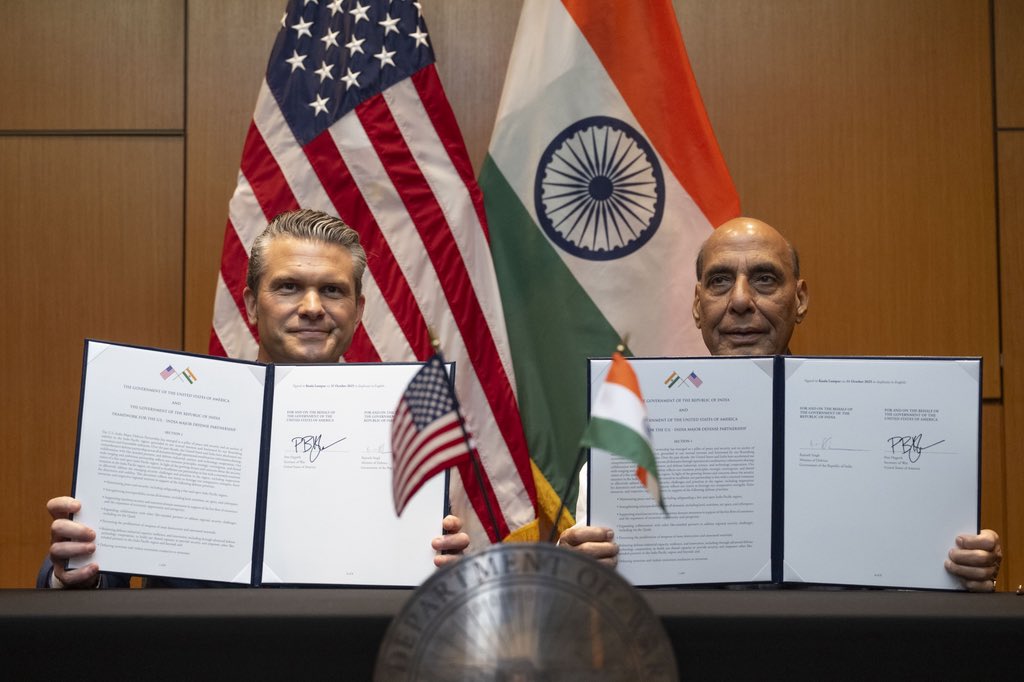India, US Seal 10-Year Defence Pact to Deepen Strategic Partnership Amid Shifting Global Order
India and the United States have signed a 10-year framework agreement to expand and deepen their defence cooperation, signalling a new phase in their strategic partnership. The deal was formalised during a bilateral meeting between Indian Defence Minister Rajnath Singh and US Defence Secretary Pete Hegseth on the sidelines of the 12th ASEAN Defence Ministers' Meeting Plus (ADMM-Plus) in Kuala Lumpur.
The agreement lays out a unified vision for advancing military collaboration across all domains, including interoperability, joint technology development, intelligence sharing, and coordination with regional allies.
 |
| Both leaders held cordial & constructive discussions on strengthening the India-US defence partnership. Via:Pete Hegseth |
“It is a signal of our growing strategic convergence and will herald a new decade of partnership,” Singh posted on X. “Defence will remain a major pillar of our bilateral relations. Our partnership is critical for ensuring a free, open and rules-based Indo-Pacific region.”
I just met with @rajnathsingh to sign a 10-year U.S.-India Defense Framework.
— Secretary of War Pete Hegseth (@SecWar) October 31, 2025
This advances our defense partnership, a cornerstone for regional stability and deterrence.
We're enhancing our coordination, info sharing, and tech cooperation. Our defense ties have never been… pic.twitter.com/hPmkZdMDv2
US Defence Secretary Hegseth called the framework “a cornerstone for regional stability and deterrence,” adding that the two nations are enhancing “coordination, info sharing and tech cooperation.”
The deal marks the culmination of efforts first announced during Indian Prime Minister Narendra Modi’s official visit to Washington in February, where US President Donald Trump and Modi committed to formalising a new 10-year strategic framework. It reflects the shared intent to counterbalance China's growing assertiveness in the Indo-Pacific and to build mutual resilience in emerging defence technologies.
Trump’s remarks about his self-declared role in de-escalating tensions with Pakistan had seemingly delayed the signing. However, the political urgency to demonstrate convergence has now overridden earlier irritants.
Raksha Mantri Shri @rajnathsingh met with US @SecWar Mr. @PeteHegseth on the sidelines of the 12th ADMM-Plus in Kuala Lumpur today. Both leaders held cordial & constructive discussions on strengthening the India-US defence partnership, reviewed ongoing cooperation in defence… pic.twitter.com/a1ZDqd8CEg
— Ministry of Defence, Government of India (@SpokespersonMoD) October 31, 2025
While India’s historic defence ties with Russia remain intact, the country’s arms import profile has shifted notably in recent years. Moscow’s share has declined as New Delhi accelerates diversification and builds indigenous capacity. India has also signalled its openness to purchasing more US-origin military platforms, including advanced fighter jets.
The timing of the pact is significant. It comes amid a challenging period in bilateral relations, with Washington recently imposing 50% tariffs on Indian exports and a 25% penalty on purchases of Russian oil and arms. Despite those frictions, both governments have sought to separate defence from trade disagreements.
Trade talks remain ongoing, with negotiators aiming to conclude a long-awaited agreement by November. The defence framework is seen as a strategic counterbalance that may help ease tensions and demonstrate shared geopolitical alignment, especially in the Indo-Pacific.
Had a fruitful meeting with my US counterpart @SecWar Peter Hegseth in Kuala Lumpur. We signed the 10 years ‘Framework for the US-India Major Defence Partnership’. This will usher in a new era in our already strong defence partnership.
— Rajnath Singh (@rajnathsingh) October 31, 2025
This Defence Framework will provide policy… pic.twitter.com/IEP6Udg9Iw
The agreement also follows years of steady progress in military-to-military engagement between the two countries. Joint exercises such as Yudh Abhyas and Malabar have expanded in scope and complexity, while defence technology cooperation — including on jet engines, drones, and space-based ISR systems — has moved to a new phase.
Indian and US defence officials also reviewed ongoing challenges, including maritime security, cyber threats, and the need for multilateral alignment with regional partners. The 10-year roadmap is expected to institutionalise mechanisms for strategic dialogue and co-development, setting the stage for closer collaboration across the board.
